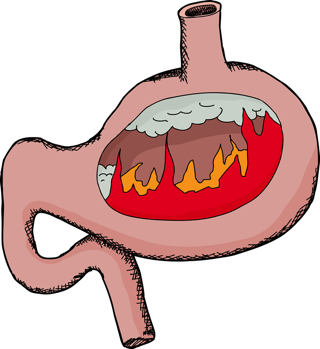
When we go to the doctor with symptoms of acid reflux, gas, bloating and heartburn, typically the diagnosis of high stomach acid is based purely on symptoms — not a lab test for stomach acid levels — resulting in a prescription for antacids, histamine type 2 receptor agonists (H2 blockers), Proton Pump Inhibitors (PPIs), or even surgery.
For many people, these drugs only worsen the problem.
Antacids reduce stomach acid temporarily, then more acid is automatically produced to bring the stomach back to its intended pH level. This only treats the temporary symptoms and does nothing to fix the actual problem.
H2 blockers block a substance in the body that encourages acid production in the stomach. They work more slowly than antacids and are intended to last for longer periods of time. On the down side, they stop production of pepsin, a digestive enzyme necessary for breaking down protein.
Proton pump inhibitors permanently block an enzyme that tells your stomach to produce acid.
All of these methods are linked to serious side effects and can even contribute to the root causes of continued chronic low stomach acid and other serious health conditions.
5 Ways to test stomach acid levels
Because hypochlorhydria isn’t well known to most patients, many never trace it back to their chronic health condition and they continue to suffer.
The good news is multiple options exist for testing stomach acid levels, which will help you create a clear game plan for remedying the situation at its foundation.
1. Gastric acid secretion test. Highly invasive and expensive, this test is typically done if a patient is diagnosed with a stomach ulcer. It can be helpful to track if anti-ulcer medication is working and to see if material from the intestines is coming back into the stomach.
2. The Heidelberg Stomach Acid Test. Considered the gold standard test for hypochlorhydria, a small capsule with a radio transmitter is ingested to measure the pH of the stomach as you drink a solution with baking soda (reduces acidity). The baking soda will naturally neutralize the HCL in the stomach. If the body does not return it to normal, it’s a sign of hypochlorhydria.
This test provides a graph showing your specific stomach response to the baking soda challenge, and can help determine if you have hypochlorhydria, hyperchlorhydria (high acid), or achlorhydria (complete lack of acid). At a cost of about $350, this test is not covered by most insurance plans.
3. CBC and CMP. These are common factors on a metabolic blood panel, typically covered by insurance. A skilled clinician can diagnose hypochlorhydria by taking into account these lab results in combination with your symptoms.
4. Betaine HCl challenge. An at-home test considered to be quite reliable, however false positives are possible, so it’s recommended to repeat the test three times. The betaine HCl costs about $20. If you have low stomach acid, you can then take it to help restore your HCl levels.
- Buy Betaine HCl with pepsin.
- Eat a high-protein meal containing at least 6 ounces of meat (veggies are allowed with this).
- In the middle of the meal (not the beginning) take one betaine HCl pill.
- Finish the meal and observe what happens.
Possible outcomes:
1. You notice no symptoms. This is likely a sign of low stomach acid.
2. Indigestion. Burning, heat, or heaviness in your chest likely indicate adequate stomach acid levels.
It is recommended to repeat the betaine HCl challenge two or three times to confirm your results. Three positive tests are a good indication of low stomach acid.
False positives are possible if:
- You consume too little protein. A low protein meal doesn’t require much acid, so the betaine HCl can cause too much increase in acid.
- You took the capsule before the meal, which can cause indigestion.
- You have esophageal sphincter dysfunction. A hiatal hernia or poor esophageal sphincter tone can cause increased indigestion symptoms. Rule this out with a medical exam if you suspect it.
5. Baking soda stomach acid test. While not as accurate as the above tests, this is a free at-home test you can use to get an indication of your stomach acid levels. The results can vary from person to person depending on interpretation of the results. Some use it as a baseline measure and to track changes over time.
First thing in the morning, before eating or drinking anything:
- Mix ¼ tsp baking soda in 4 to 6 ounces of cold water.
- Drink the baking soda solution.
- Time how long it takes for a burp to occur. Time it for up to 5 minutes
If you have not burped within five minutes, it may be a sign of insufficient stomach acid. Early and repeated burping may be due to too much stomach acid (do not to confuse this with small burps from swallowing air when drinking the solution). Any burping after 3 minutes is an indication of low stomach acid levels.
Associated tests
Low stomach acid can be associated with other health issues that have far-reaching consequences. If you suspect low stomach acid, ask our office about testing for the following:
B12 levels: Intrinsic factor is a glycoprotein in the stomach necessary for absorption of vitamin B12. When stomach acid is too low, intrinsic factor can’t do its job. This results in vitamin B12 deficiency, which is a serious health concern.
Homocysteine levels: Stomach acid is important for proper absorption of vitamin B12, a key factor in methylation that keeps inflammatory homocysteine at the right levels. When B12 is low, homocysteine elevates.
Supporting healthy stomach acid
Eat protein foods at the beginning of your meal to stimulate the digestive enzymes necessary for digesting protein.
Chew thoroughly. This is one of the most important parts of digestion. Food proteins need to be broken down to be properly digested.
Limit liquid intake during meals until at least 30 minutes after a meal to allow for proper stomach acid production, pathogen sterilization, and protein metabolism.
Stay hydrated between meals to support proper gut motility; this pushes the contents of the intestines out of the body instead of back into the stomach. This is very important for those who are prone to SIBO.
Betaine hydrochloride supplements help support healthy gut function and safely restore normal gastric acidity. (Do not confuse betaine HCl with anhydrous betaine, a methyl-donor nutrient taken to control homocysteine levels.)
Always take the betaine HCL either half-way through the meal or right at the end of the meal. Taking it before a meal may create a false experience of heartburn and can turn off stomach acid production for this meal. Caution: Do not take HCL if you are taking any NSAIDs such as ibuprofen, Tylenol, or aspirin.
HCl with pepsin. Add these to your diet when you consume protein. When you feel warmth in your stomach, that means you are taking enough. Then back it down a notch and monitor your response. Some people need one capsule, others need more as everyone is unique.
Pepsin. Typically used in conjunction with HCl, pepsin is considered very safe when administered to assist digestion.
Digestive enzymes help to break down food proteins. Make sure to get a high-quality blend.
Apple cider vinegar. One tablespoon in a bit of water right before a meal can help with digestion.
Fermented foods such as sauerkraut, kimchi, pickles, pickled ginger, and water kefir contain organic acids, enzymes and probiotics to assist with proper digestion. They are also anti-microbial and fight H. pylori, arch enemy of stomach acid production.
Taking the time to improve your stomach acid levels will make a huge difference in your symptoms and quality of life. Please contact my office for more help.



Latest from the Blog
The Death of Red Dye #3
January 15, 2025What Is Red Dye No. 3? Red Dye No. 3, or Erythrosine, is a synthetic food color derived from coal tar. It was first approved by the FDA in the 1950s and quickly became one of the most popular artificial colors in food and cosmetics. Red Dye No. 3 was used in everything from candies, […] Read more
Latest from the Blog
Do You Know What Is In Your Protein Powder?
What’s Really in Your Protein Powder? Understanding the Risks Protein powders are a staple in many health-conscious diets, from athletes seeking muscle recovery to those simply aiming to boost their daily protein intake. With a wide variety of options available, choosing the right one can feel overwhelming. However, recent findings have raised concerns about what’s […] Read more